| Latino Railroad Pioneer
Honored
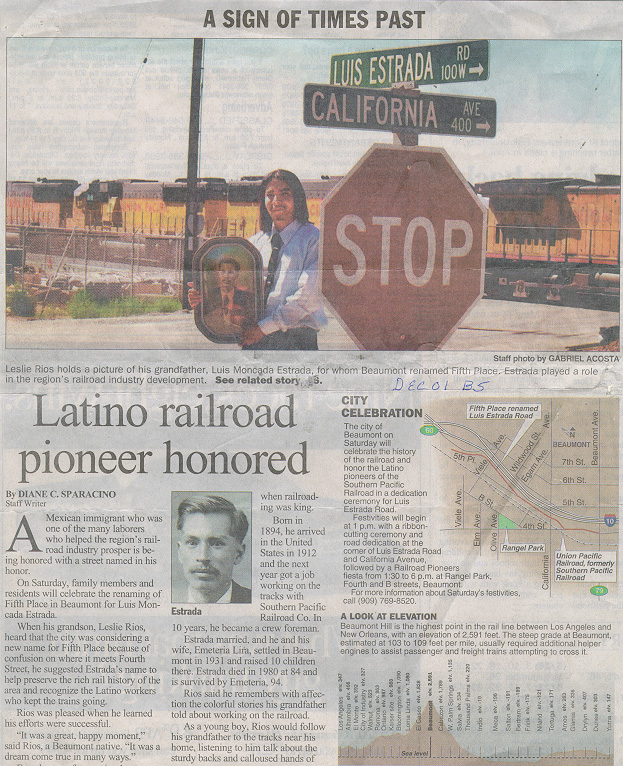
The city of Beaumont, California celebrated the
history of the railroad and honored the Latino pioneers of the
Southern Pacific Railroad in a dedication ceremony for Luis Estrada
Road on July 19, 2001.
When Luis Estrada’s grandson, Leslie Rios, heard
that the city was considering a new name for Fifth Place because of
confusion on where it meets Fourth Street, he suggested his
grandfather’s name to help preserve the rich rail history of the
area and recognize the Latino workers who kept the trains going.
Born in Mexico in 1894, Estrada came to the U.S. in
1912 and the next year got a job working on the tracks with Southern
Pacific. In 10 years, he became a crew foreman. He married, settled in
Beaumont in 1931, raised 10 children there, and died in 1980.
Rios told the San Bernardino Sun he remembers
with affection the colorful stories his grandfather told about working
on the railroad. Rail work was difficult, Rios said his grandfather
told him, and only the hardiest of souls could tolerate the intense
heat and pounding labor.
In the early days before cranes were used, crews of
six to 12 men had to lift rails. Early in the 1900s, wooden cargo cars
known as campo trains were used to house and transport workers. As
many as 12 men lived in the cars, which had bunk beds, wood-burning
stoves and kerosene lamps.
Rios said his grandfather told him that during World
War II, crews worked around the clock to ensure the safety of the
troops, checking tracks for sabotage. Crews patrolled the tracks at
night using flashlights to keep them safe and clear of debris.
The railroad built houses for employees’ families
near the tracks. That’s where the Estrada family lived for decades.
The wooden dwellings, some measuring 10 by 15 feet, had little room
for growing families and for many years lacked plumbing. "We had
a big tin tub where we used to take a bath. We had to all fit in
there," said Soledad Fierro, 73, the eldest daughter of the
Estrada family.
In the mid-1940s, Estrada retired and built a home
behind company housing on land he purchased in an area where many
early workers eventually settled. "A good percentage of
descendants still live there," Rios said. Beaumont’s Mexican
immigrant trackside barrio is a source of pride and the homes are
well-tended. Development and growth has claimed about 30 homes, but a
church and 50 dwellings, including a few adobe structures from the
1920s, remain. The original trackside housing was torn down in 1961.
Rios said the renaming of the street for his
grandfather is a significant step in acknowledging the importance of
the historic barrio, connecting the integral role of the railroad to
the many residents who labored to keep the trains moving.
FOR THE CHILDREN
The founders and coordinators of the For The
Children handcar fund raiser, Gary Mang and his wife April, sent the
following letter to the Friends of FTC after this year’s seventh
annual event on August 19 in McHenry, Illinois.
Each year, April and I make it a point to write
these thank you letters to you. As usual, we can not express enough
thanks. We can tell you that your participation — whether buying a
shirt, volunteering, racing or sponsoring this event — made a
difference in saving and improving quality of life for a child. With
your help we have raised over $138,000 in seven years. This year alone
we reached an event record of $31,000.
Despite the rain, wind and cold weather, we had over
50 teams racing. We crowned a new champion handcar team when they
reached record breaking time — 300 meters in 36.248 seconds —
breaking the old record by two seconds.
Our vendor fair was very active and informational.
The booths ranged from the Police Department displaying safety
literature to the railroad suppliers showing new innovative equipment.
There was a little something for everyone.
We had several pints of blood donated and the best
barbecue in the state. We had more than enough food. In fact, we ended
up donating extra food and drinks to the Home of the Sparrow. It’s a
shelter for battered women and children. We also had a new event added
to FTC this year. A motorcycle run. It started in Chicago and ended up
at the park for lunch time, raising several hundred dollars to donate.
We do appreciate your continued support and hope you
will still be on board for next year’s event. Please spread the news
about our event. Invite and bring your family, friends and coworkers
next time.
Stay tuned for details on our upcoming events by
visiting our website www.handcar.com, or as always, by calling
us at 847-623-6155. Next year’s race is scheduled for August 18,
2002. Mark your calendars.
Editor’s Note: Donations can always be made by
sending them to For the Children, P.O. Box 562, Lake Villa, Illinois
60046.
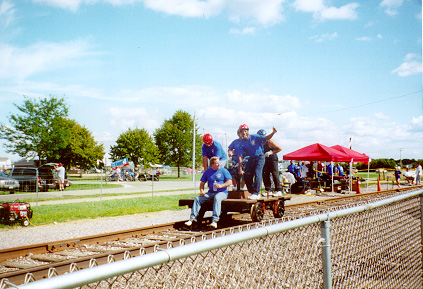
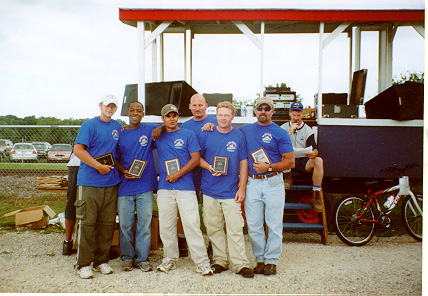
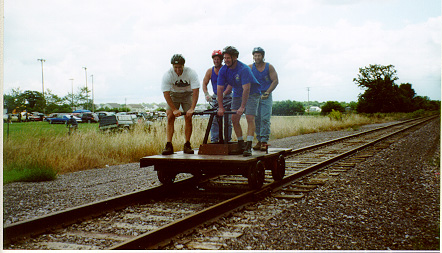
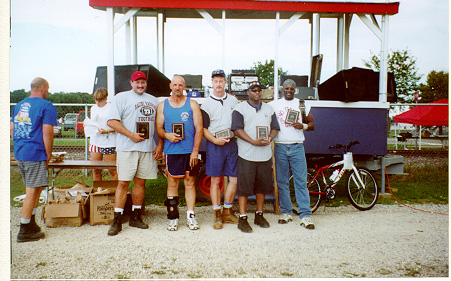
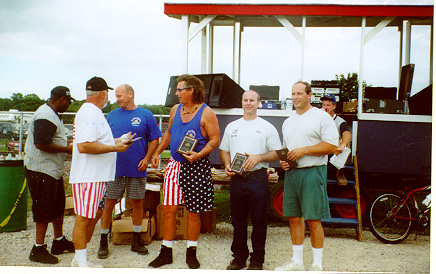
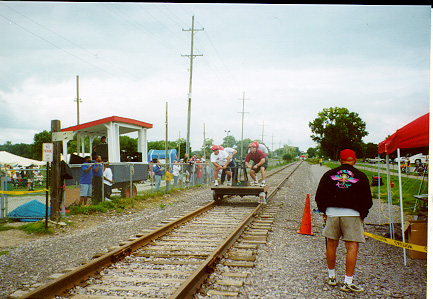
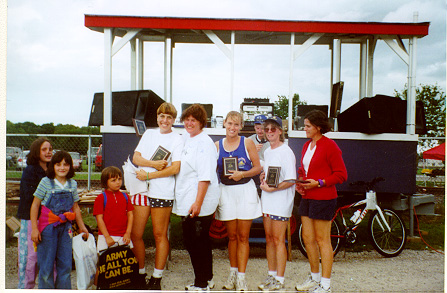
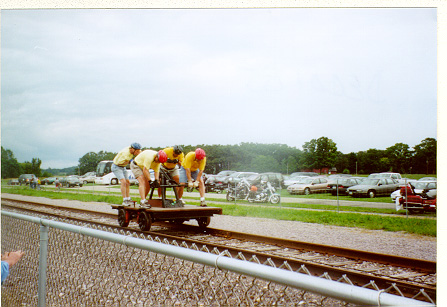
BMWE "GO TEAM" Designated by NTSB
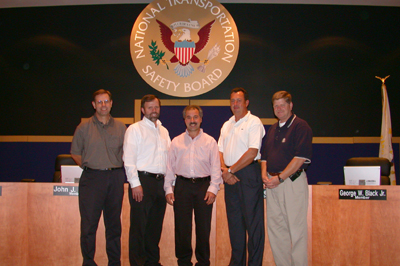
BMWE NTSB GO TEAM: Left to right, David Joynt,
David Tanner, Rick Inclima, Rick Procise, Randall Brassell.
Five BMWE members attended a National Transportation
Safety Board training session on accident investigation at NTSB
headquarters in Washington, DC, August 30, 2001. Successful completion
of NTSB’s program allows BMWE to be granted "party status"
by NTSB and participate in Safety Board investigations. The NTSB
expressed a desire to establish a voluntary BMWE "go-team"
which can be activated to assist NTSB in investigating major railroad
accidents and fatalities.
The National Transportation Safety Board is an
independent federal agency with the statutory responsibility to
promote transportation safety by conducting independent accident
investigations. Each year the Safety Board investigates more than
2,000 aviation accidents and about 500 rail, highway, marine and
pipeline accidents. BMWE had been granted party status in several
major NTSB investigations in the past and that experience had prompted
NTSB to seek to formalize BMWE’s participation and go-team status.
This training provided BMWE participants with an understanding of NTSB
activities and prepared them as party specialists in railroad accident
investigations.
BMWE President Mac A. Fleming sought to have a BMWE
representative from each of the four major Class I Railroads trained
for go-team status. After consultation with a number of General
Chairmen, the following BMWE representatives were designated to
participate: Randall Brassell, Vice Chairman, Allied Eastern
Federation (CSX); David Joynt, General Chairman, Burlington System
Division (BNSF); Rick Procise, Vice Chairman, Affiliated System
Federation (NS); David Tanner, General Chairman,Union Pacific System
Division (UP); and Rick Inclima, BMWE Director of Education and
Safety.
President Fleming stated, "BMWE go-team status
will provide us an opportunity to have our own representatives on site
and actively pursuing the facts in cooperation with NTSB investigators
within hours of a major accident and before evidence could be
compromised. This will help ensure that the maintenance of way
perspective be given appropriate consideration in the cause and
prevention of certain railroad accidents. I am pleased that NTSB has
recognized BMWE’s efforts and contributions in the area of railroad
safety and the expertise and experience we bring to the table in
identifying accident causes and accident prevention."
When participating in an NTSB accident
investigation, BMWE team members must, by law, conduct themselves
within the bounds of certain federal regulations issued by the NTSB
for all participants. The nature of an NTSB investigation is such that
by regulation, there are no adverse parties, or opposing sides, and
the investigation is strictly for the purpose of fact finding.
When the NTSB conducts an investigation, either
major or regional, it designates one member of their team sent to the
accident scene to be the Investigator-in-Charge or IIC. The NTSB - IIC
has certain legal powers granted to him by administrative law.
Essentially, the IIC organizes, conducts and controls the field phase
of the investigation, and during follow up phases. Also, the IIC
supervises all of the Board personnel on site.
The IIC decides upon formal granting of "Party
Status" to organizations like the BMWE. Granting of Party Status
to a group or organization means that they become an official part of
the investigation, entitled to make inputs, participate in field
investigations, submit safety recommendations, etc. This formally
takes place during an on-site "Organizational Meeting" which
usually occurs within hours after arrival on scene by the NTSB group.
Organizations holding Party Status would not only be
present during interviews of its personnel (as could a group without
Party Status), but additionally, groups with Party Status would remain
on site after the interview, to be continuously present and
contributing to the cause finding efforts during the entire term of
the investigation.
Typically, a major investigation takes three to
seven days to complete the active field phase. A regional
investigation takes from one to three days to complete the active
field phase. After the initial on-scene investigation is complete, a
group granted party status may also be asked to participate in any
scheduled hearings, follow-up tests, interviews or studies. Party
status will also allow BMWE to participate in the technical review of
the completeness of the factual portion of the investigation.
Parties do not participate in the analysis of
drafting the final NTSB report. However, parties can contribute to the
analytical process by submitting their own findings, recommendations
and probable cause based on the factual reports. These "party
submissions" become part of the public docket and are considered
by staff and the Board Members before adoption of the final report by
the Board. The time frame from accident to release of the probable
cause information is about one year.
"In several major accident investigations over
the past decade in which BMWE was granted party status by NTSB, we
were able to enter facts into the investigation that may not have
otherwise been revealed. As such, we have been able to protect BMWE
members from being scapegoats for accidents that probably would have
been blamed on them alone if BMWE were not there to uncover the
underlying causes and contributing factors. I have every confidence in
BMWE’s go-team representatives and their ability to contribute to
NTSB’s findings of fact and probable cause where track conditions or
roadway worker protection issues arise," Fleming said.
LABOR DAY 2001
by John J. Sweeney, AFL-CIO President
Labor Day is a good time to take a look at where we
are as a movement and where we are heading. One hundred nineteen years
after America’s first Labor Day parade, we’re still fighting for
the freedom of working people to choose to improve their lives through
union membership.
Not only are employers still waging war against
workers struggling to organize, they have gained support from a
presidential administration so beholden to Big Business it has
launched the most concerted attack on workers’ rights and
protections in a generation.
We are up against a gross corporate agenda warping
the global economy to produce profits at any human cost. And the
massive millionaire tax cut pushed by President George W. Bush
threatens America’s ability to invest in meeting such basic needs as
education, health care and retirement security.
In this environment, America sorely needs the
vision, values and activism of working families and their unions. We
have a job to do in refocusing our nation on a vision for the future
that is free of social and economic injustice — and in moving our
society to a new level of commitment to the shared values of respect
for work, family and community.
It’s time for us to challenge America to unite in
battle against the unnecessary evils that drag down living standards
and drive wedges between us: the loss of good jobs, neglected and
overcrowded schools, child poverty, lack of health care, unaffordable
prescription drugs, enduring forced labor and child labor, trade deals
that hurt workers around the world, exploitation of immigrant workers,
discrimination in every form and damage to our environment.
We must reject the claim that America can’t afford
to carry out its vision of the future we want our children to inherit.
We can’t afford not to invest in our future.
And we must challenge ourselves to bold new levels
of organizing and the scale of growth that will make it possible for
us to elect and hold leaders accountable to honor the people who build
our homes, clean our offices, teach our children, patrol our streets,
care for our sick and elderly loved ones, fly our planes, drive our
trucks, build our cars and more. It will require unprecedented union
strength to redirect this economy to respect workers, our families and
our communities.
This Labor Day, talk to people, get on the airwaves,
address your congregation and issue a challenge to join today’s
unions in an all-out crusade to bring about a better future for
working families. Together, we can do great things! |

